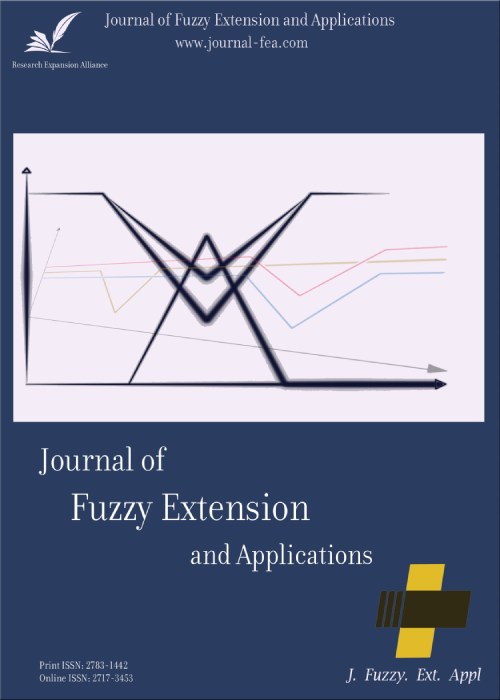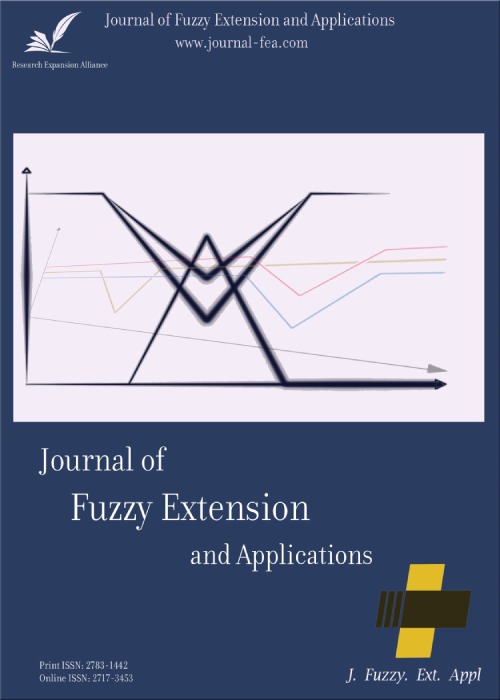فهرست مطالب

Journal of Fuzzy Extension and Applications
Volume:4 Issue: 3, Summer 2023
- تاریخ انتشار: 1402/04/10
- تعداد عناوین: 7
-
-
Pages 148-154In communication networks, strong connectivity between nodes is critical. The failure of strong connectivity between nodes may jeopardize the network’s stability. In fuzzy graphs, various dominating sets using strong edges are identified to avoid network stability. In this paper, the concept of bridge domination set and bridge domination number in fuzzy graphs is introduced. A few prominent properties of bridge domination numbers are chosen and analyzed using relevant examples. The bridge domination number of fuzzy trees, constant fuzzy cycles, and complete fuzzy and bipartite fuzzy graphs are identified. The use of bridge domination in a partial mesh topology to ensure network continuity is demonstrated in the event of a node failure.Keywords: Fuzzy graph, domination set, Domination number, connected bridge domination, Mesh Topology
-
Providing a hybrid fuzzy approach to explain managers’ mental paradigms to prioritize employee needsPages 155-172Today, most manufacturing and service companies adopt a customer-oriented approach to take into account employee needs and expectations as a strategic principle for sustainability and success in a competitive market. Meanwhile, Sengeh argues that “many of the best ideas and strategies will not be realized due to the conflict between new ideas and managers’ subjective model, rather than the management weakness”. On the other hand, managers’ decisions based on self-developed rules can suffer all kinds of biases. As Bierzman explains: “managers’ mental heuristic rules lead to weak analysis of information, inappropriate weighting of the various data, and an investigation of few alternatives for decision-making, which can lead to systematic errors and common biases in the decision”. Addressing the existing gap between managers’ subjective perceptions of employees and employees’ self-perceptions, the present study aims to present a new systematic approach with a combination of Delphi, Kano and AHP methods in an attempt to explain managers’ mental paradigms in Abadan Oil Refinary Company as one of the elading ones in the Middle East. The statistical population of the study consists of 18 experienced managers (using snowball method) and 203 employees at Abadan’s Oil Refinery (using the Cochran formula). The validity and reliability of the questionnaire were also confirmed using Kendall’s Correlation Coefficient, Cronbach’s Alpha coefficient, and Gogus and Butcher’s Incompatibility Rate. First, needs were determined from the views of the experts using the Fuzzy Delphi method, and then, Kano’s non-linear model and Alpha-cut (α-Cut) method were used to classify 21 components as basic, performance, and excitement needs. In the end, the needs have been ranked using the Fuzzy AHP method. The results indicated that the proposed method was effectively successful in reducing biases, vagueness, and possible inconsistencies in managers' decisions and judgments. Overall, the method presented insights on the significance of future strategic decisions to achieve sustainable competitive advantages and to increase employee satisfaction while categorizing the needs optimally as confirmed and welcomed by decision-making experts.Keywords: Employee needs, expectations, Fuzzy Kano model, fuzzy AHP, Managers’ mental paradigms
-
Pages 173-187In this paper, we define the conceps of complex fuzzy Lie subalgebras and complex fuzzy ideals of Lie algebras with respect to t-norms and investigate some of characteristics and relationship between them. Next, we introduce the concepos of quotient subalgebras, intersection, sum and direct product of them and prove some results about them. Finally, we introduce and study the image and the inverse image of them under Lie algebra homomorphisms.Keywords: Lie algebras, Ideals, Fuzzy Set Theory, t-norms, Complex fuzzy sets, Intersections, homomorphisms
-
Pages 188-206The reliability of software product is seen as critical quality factor that cannot be overemphasized. Since real world application is loaded with high amount of uncertainty, such as applicable to software reliability, there should be a technique of dealing with such uncertainty. This paper presents a reliability model to effectively handle uncertainty in software data to enhance reliability prediction of software at the early (requirements and design) stages of Software Development Life Cycle (SDLC). In this paper, a hybrid methodology of Takagi Sugeno Kang (TSK)-based Interval Type-2 Fuzzy Logic System (IT2FLS) with Artificial Neural Network (ANN) learning is employed for the prediction of software reliability. The parameters of the model are optimized using Gradient Descent (GD) back-propagation method. Relevant reliability software requirement and design metrics and software size metrics are utilized as inputs. The proposed approach uses twenty-eight real software project data. The performance of the model is evaluated using five performance metrics and found to provide output values that are very close to the actual output showing better predictive accuracy.Keywords: Software Reliability, software metrics, Software fault prediction, ANN, Fuzzy logic, Interval Type-2 Fuzzy Logic System, Gradient descent algorithm
-
Pages 207-216
Many real-world problems face strenuous in making decisions. Many theories have evolved for dealing with such problems. The present paper deals with Fuzzy Binary Soft Sets and their applications to Multi Criteria Decision Making (MCDM) problems. Then introduced an expanded matrix representation of Fuzzy Binary Soft Sets, an extended resultant matrix, and operator, and an algorithm to solve a proposed problem.
Keywords: Fuzzy binary soft set, matrix representation, expanded matrix representation -
Pages 217-234
Fire is a natural disaster that poses a profound existential threat to humanity. It has traditionally been fought with conventional methods, which, unfortunately, are often fraught with limitations and potential environmental damage. Given these limitations, there is an urgent need for research into novel firefighting methods. Sound wave-based firefighting systems, an emerging solution, show promising potential in this regard.The current study uses an extensive data set derived from numerous experimental trials of sound-wave-based firefighting. Based on this extensive dataset, we have developed a sound wave technology-based fire suppression model that includes five different fuzzy logic methods Fuzzy Rough Set (FRS), Fuzzy K-Nearest Neighbors (FNN), Fuzzy Ownership K-Nearest Neighbors (FONN), Fuzzy-Rough K-Nearest Neighbors (FRNN), and Vaguely Quantified K-Nearest Neighbors (VQNN).The main objective of these models is to accurately distinguish between the extinguished and non-extinguished states of a flame. This classification is based on a number of intrinsic model parameters, such as the type of fuel, the size of the flame, the decibel level, the frequency, the airflow, and the distance.To evaluate the classification effectiveness of the models, a number of statistical methods were used, including Mean Absolute Error (MAE), Root Mean Square Error (RMSE), Kappa Statistics (KP), and Mean Square Error (MSE).Our analysis yielded promising results, with the models FRS, FNN, FONN, FRNN, and VQNN achieving classification accuracies of 93.12%, 96.66%, 95.56%, 96.35%, and 96.89%, respectively. These results confirm the high accuracy of the proposed model in classifying fire data and underline its practical applicability.
Keywords: Acoustic Oscillations, Fire Suppression, Fuzzy classification, Firefighting Techniques, Sound wave Acoustic -
Pages 235-245The q-Rung Orthopair Fuzzy set (qROF-set) environment is a contemporary tool for handling uncertainty and vagueness in decision-making scenarios. In this paper, we delve into the algebraic examination of q-rung orthopair Multi-Fuzzy Sets (MFSs) and explore their operational laws. The novel q-Rung Orthopair Multi-Fuzzy subgroup (qROMF-subgroup) is the extension of Intuitionistic Multi-Fuzzy Subgroup (IMF-subgroup) to encompass the domain of groups. The properties of the proposed fuzzy subgroup are examined in detail, and the paper concludes by defining two additional concepts: qROMF-coset and qROMF-normal subgroup. Finally, we present a comparison of the newly introduced model with existing approaches to validate its superior performance.Keywords: qROMF-set, qROMF-subgroup, qROMF-coset, qROMF-normal subgroup


